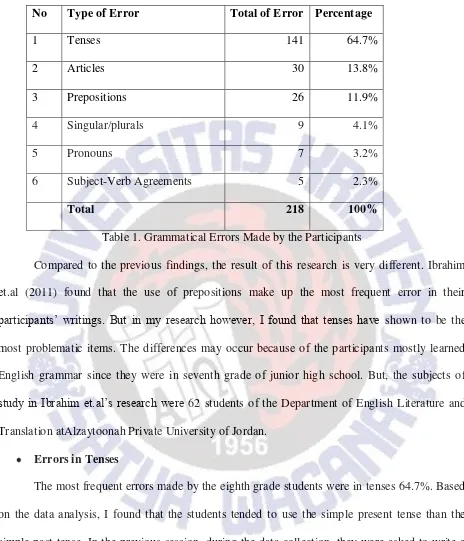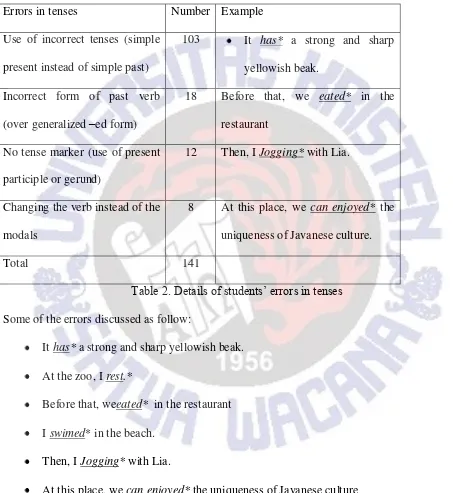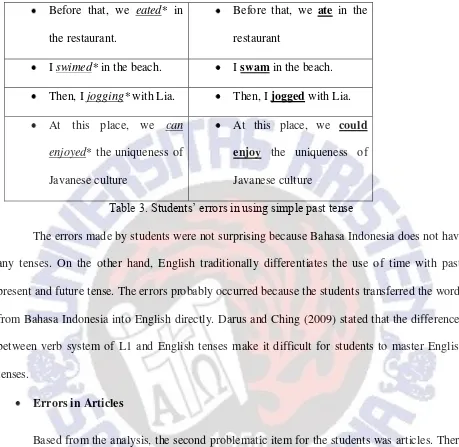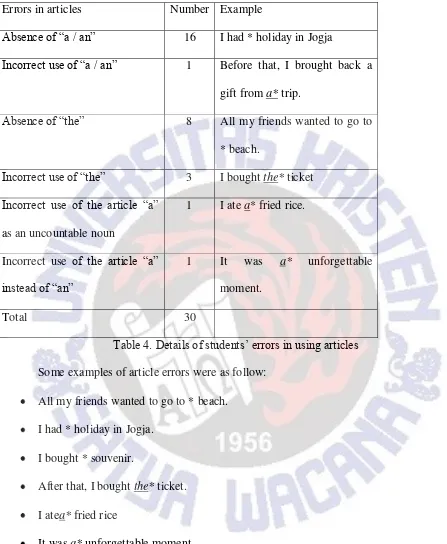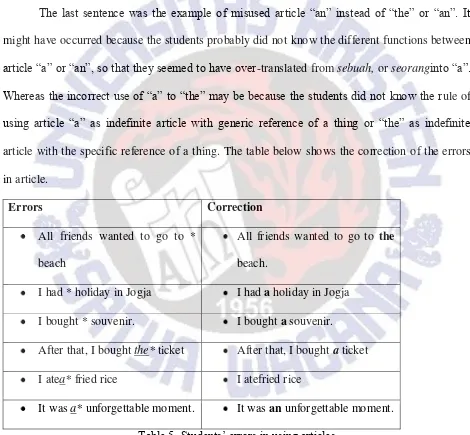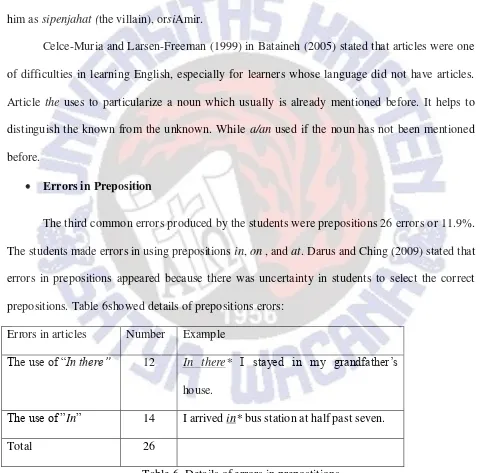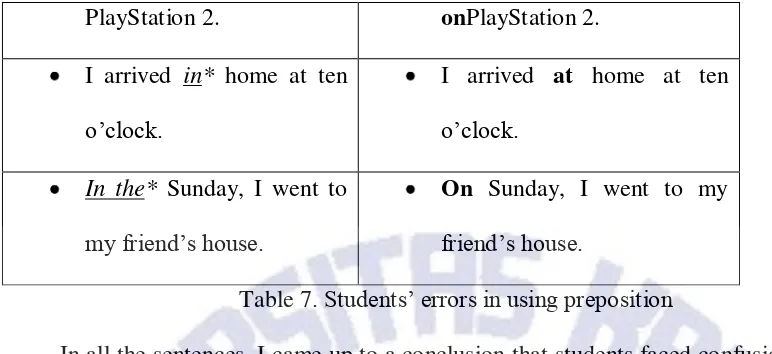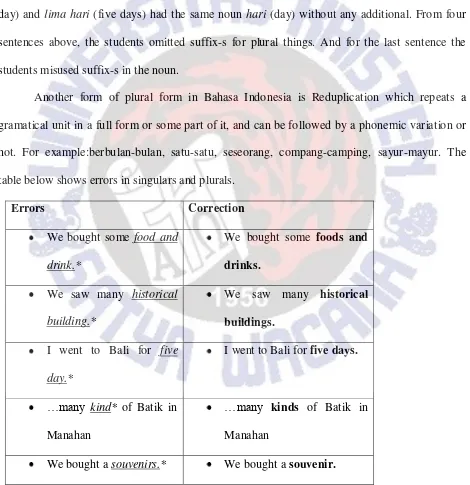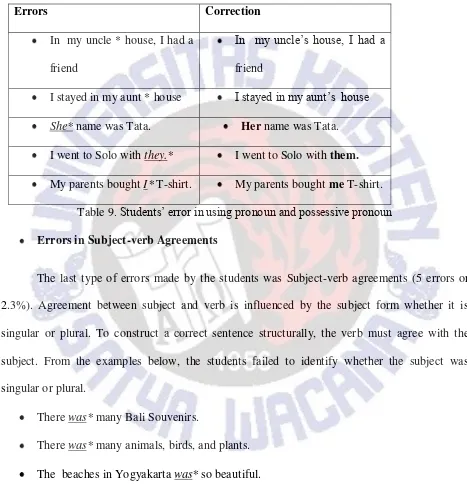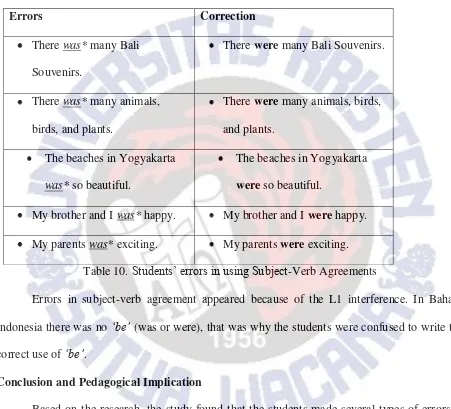1
STUDY OF GRAMMATICAL ERRORS MADEBY EIGHT GRADERSOF
SMP 2 AMBARAWA IN WRITING RECOUNT
THESIS
Submitted in Partial Fulfillment
of the Requirements for the Degree of
SarjanaPendidikan
RestyFebrianty
112011704
ENGLISH DEPARTMENT
FACULTY OF LANGUAGE AND LITERATURE
SATYAWACANACHRISTIANUNIVERSITY
2
STUDY OF GRAMMATICAL ERRORS MADE BY EIGHT GRADERS OF
SMP 2 AMBARAWA IN WRITING RECOUNT
THESIS
Submitted in Partial Fulfillment
of the Requirements for the Degree of
SarjanaPendidikan
RestyFebrianty
112011704
ENGLISH DEPARTMENT
FACULTY OF LANGUAGE AND LITERATURE
SATYAWACANACHRISTIANUNIVERSITY
3
4
COPYRIGHT STATEMENT
This thesis contains no such material as has been submitted for examination in any course or accepted for the fulfillment of any degree or diploma in any university. To the best of my knowledge and my belief, this contains no material previously published or written by any other person except where due reference is made in the text.
Copyright@ 2013. RestyFebrianty andDr. ElisabetTitikMurtisari, SPd, MTransStud.
All rights reserved. No part of this thesis may be reproduced by any means without the permission of at least one of the copyright owners or the English Department, Faculty of Language and Literature, SatyaWacana University, Salatiga.
6
STUDY OF GRAMMATICAL ERRORS MADE BY EIGHT GRADERS OF SMP N 2 AMBARAWA IN WRITING RECOUNT
RestyFebrianty
Abstract
This study aims to investigate the types of grammatical errors found in eight graders in recount writing. The data were collected from 20 students‟ essays of their holiday experience. In analyzing the data, I used steps suggested by Corder (1974) applied by Ellis and Barkhuizen (2005). With this method, a native speaker teacher helps identify the grammatical errors in the students‟ work and these errors are later classified based on Politzer and Ramirez‟s Linguistic Taxonomy (1973). Finally, based on the identification of errors, each category of errors was counted to find each proportion and explained and discussed.
Key words: error analysis, grammatical error, linguistic taxonomy
Introduction
Learning a foreign language may pose many challenges. There will always be errors that may occur not only in listening, speaking, reading but also writing. In a learning process, finding second language learners‟ errors is an evidence of a process of learning. Error has played an
important role in the study of language acquisition (Lengo, 1995, p.20). Many learners seem to find writing the most difficult skill to acquire. Richards and Renandya even claims that writing is the most difficult skill for second language learner to master, because the skills involved in writing are highly complex. (2002, p.303)
7
different from writing in first language. Shen (1988, p.461) says, “In order to write a good
English, I knew that I had to be myself, which actually meant not to be my Chinese self. It meant that I had to create an English self, and be that self.” From what Shen explains, in composing a good writing, learners have to think like the native speakers, that is why grammar is one of important aspect that they should be capable of in making a good writing text.
Grammar in second language teaching sounds very old-fashioned to some people, but the fact is grammar takes an important role in communicative approach for those who learn English as their second language. Richard and Renandya (2002, p.145) believes that people now agree that grammar is too important to be ignored, and that without a good knowledge of grammar, learners‟ language development will be severely constrained. From this explanation I want all
my thesis readers would like to be aware of the era of “Grammar Crisis” in which there are many people who do not consider a good grammar in their communication. Grammar has many important essences to communicate with each other; it helps the speakers to construct their brief idea better in every aspects of communication including, business, education and many other field, to have an effective communication, and reduce the level of misunderstanding between the speakers and listeners, and it also helps the speakers to have a good credibility of educated person.
8
formation, linguistic semantics, pronunciation and spelling. In line with this, Hymes (1972) said that the notion of communicative competence is the underlying knowledge a speaker has of the rules of grammar including phonology, orthography, syntax, lexicon, and semantics, and the rules for their use in social appropriate circumstances.
Based on the explanation above, I assume that grammar is central in language learning. One cannot be said to have learned a particular language, without knowing the grammar. People learn how to concept a good message based on the rules they have known and try to convey the message to the others, and these rules are termed as grammar.
In creating a writing product, making errors in grammar are expected. AnchaleeSattayatham and PongratRatanapinyowong (2008) find many students have difficulty in using English grammar. Error analysis plays an important role in this aspect because it can help in students‟ error recognition and thus aid students in writing good paragraphs after they learn
how to correct these errors through practice.
Although errors are common in daily life, people learn better from their errors. In identifying second language learners‟ errors, Ellis (1998) points out that we will see two
different kinds of negative production in second language performance, which are mistake and error. That is why in order to analyze learners‟ errors in learning English as a foreign language, it
will be better to make a distinction between mistakes and errors. According to Brown (2004, p.216) “an error is a noticeable deviation from the adult grammar of a native speaker, reflecting
the interlanguage competence of the learner.” From this explanation I assume that errors can be
9
A simpler definition of errors and mistakes according to Edge (1989) cited in Ancker (2000, p.20) is “an error is what a learner cannot self-correct, and a mistake is what a learner can
self-correct. So as a conclusion based on Brown‟s and Edge‟s opinions, errors are a deviation from the native speaker‟s grammar reflecting the learner‟s competence, but cannot be self -corrected by them, whereas mistakes are native speaker‟s grammar deviation which can be self
-corrected.
From those linguists‟ explanation above, this study focused only on grammatical errors.
In language learning, there are two types of errors which are interlingual errors and intralingual errors. According to Eun-pyo (2002) interlingual errors are commonly known as transfer errors. It occurred as the result of learners‟ first language features, such as lexeme and grammar. This definition is similar to Ellis‟s description about interlingual errors (1998) when second language
learners commit errors which could be traced back to the first language, those errors are known as interlingual errors. Interference from first language is usually the cause of second language learners‟ errors as Towell and Hawkins (1994) describe that L1 transfer is likely to affect all
linguistic levels including phonetics/phonology, morphology, lexicon, syntax and discourse. AnchaleeSattyatham and PongratRatanapinyowong from Silpakorn University Bangkok (2008) found that the sentence „I hungry very much‟ produced by Thai learners is a clear
example of a transfer of Thai grammatical structures into English. According to Thai grammatical structures, similar to Bahasa Indonesia grammatical structures, adjectives exist in the verb position and so do not need „be‟ in front of the adjective. This example illustrates that
learners‟ first language, Thai, has a negative effect on their second language learning which
10
On the other hand, intralingual errors occur as a result of learner‟s failure in
comprehending language (Eun-pyo, 2002). Richards (1974:124) defines, intralingual errors reflect the general characteristics of rule learning such as faulty generalization, incomplete application of rules and failure to learn conditions under which rules apply. An example of intralingual errors can be found in Abushihab, et al ‟s journal which analyzed the grammatical errors made by Arab learners in Alzaytoonah Private University of Jordan (2011), the sentence “I
saw many womans.” The use of “womans” instead of “women” is an example of an
overgeneralization error when learners create their own rules for the plural noun form.
Even though there are different types of errors in writing, this study focused only on interlanguage errors made by English learners on their writing. Knowing the common errors in writing means finding out how well learners understand and know the language they learnt (Lennon, 1991). Some research about grammatical errors in writing has been done recently. A study conducted by Ibrahim et al (2011) who investigated and classified the grammatical errors in the writings of 62 students of the Department of English Literature and Translation at Alzaytoonah Private University of Jordan found that the largest number of errors was the errors of prepositions, which comprised 26 % of the total errors. The following next problematic areas were respectively: morphological errors, articles, verbs, active and passive and tenses.
11
their translation and found that 98 % of the students had problems grammatically, and most errors the students produced were interlingual errors, indicating the influence of the mother language.
Unlike those previous study, which mostly analyzed errors from students who learn English in secondary or university level, this study explored the errors made by the students fro m junior high school, which English firstly taught as a primary lesson in Indonesia. It is hoped that this study may provide recommendations on how to prevent learners from making any kind of grammatical errors, so that in the next level of study, they will at least decrease their number of grammatical errors in their writing, or even they can do self correction on their writing. Also, it may aid English teachers in minimizing their learners‟ errors in writing English text, and by
reading the result of this study, they may find new methods to anticipate errors making in grammar. With these reasons in mind, this study seeks to answer the research questions “What are the grammatical errors that mostly occur in recount text written by eighth grade of junior
high school students?”
12
understanding from the past time in order to inform and express what had happened. For this reason, I prefer to analyze the grammatical errors made by students in writing recount.
The Study Context of the study
The setting of this study was eighth grade of SMP N 2 Ambarawa, a small town in Semarang Residence, Central Java. Since an international standard is to be implemented in this school, the students had to be able in speak and write in English. I was quite sure that a research to avoid grammatical errors in writing English text is needed. This research focused on recount text, which was being taught in eighth grade level.
Participants
The participants of this study were twenty students of the eighth grade (8C) in SMP Negeri 2 Ambarawa, with an average level of proficiency in English, and they ranged in age from 13-14 years old, including 12 females, and 8 males. Based from my observation, English was commonly taught in a translation method, in which the students had to translate every word in their book including the texts, the questions, and the orders.
Instruments and Procedure of Data Collection
13
The data from this research were taken from 20 recount essays with the topic “My Holiday”. Each student was asked to write a recount essay of minimum 20 sentences about
holiday, in 60 minutes class session. During the class session, students were not allowed to use any kind of dictionary. As the class finished, I collected their essay, and took them for a further analysis.
Findings and Discussion
Based on the correction done by the native speaker on twenty students‟ writings, I found
218 errors which belonged to the six framework categories of grammatical errors (tenses, singular/plural, prepositions, articles, pronouns and possessive pronouns, and subject verb agreements). To answer the research question “What are the grammatical errors that mostly
occur in recount text written by eighth grade of junior high school students?” the findings
showed that the most common errors were tenses, 141 errors, followed by articles, 30 errors, 26 errors in prepositions, 9 errors belonged to singular/plurals, 7 errors related to pronoun, and the last 5 errors dealt with subject-verb agreements.
To get the percentage of each type of errors, I use the following formula:
p =
x
100%P: percentage of each error n1: total of the given error ∑ N: total of the whole error
14
No Type of Error Total of Error Percentage
1 Tenses 141 64.7%
2 Articles 30 13.8%
3 Prepositions 26 11.9%
4 Singular/plurals 9 4.1%
5 Pronouns 7 3.2%
6 Subject-Verb Agreements 5 2.3%
Total 218 100%
Table 1. Grammatical Errors Made by the Participants
Compared to the previous findings, the result of this research is very different. Ibrahim et.al (2011) found that the use of prepositions make up the most frequent error in their participants‟ writings. But in my research however, I found that tenses have shown to be the
most problematic items. The differences may occur because of the participants mostly learned English grammar since they were in seventh grade of junior high school. But, the subjects of study in Ibrahim et.al‟s research were 62 students of the Department of English Literature and
Translation atAlzaytoonah Private University of Jordan. Errors in Tenses
15
Although they had already learned about recount text and the use of simple past tense in recount text, they failed to put the verbs in the past form (verb2). From 141 errors of tenses, table 2 shows the details of tenses errors:
Errors in tenses Number Example
Use of incorrect tenses (simple
Table 2. Details of students‟ errors in tenses
Some of the errors discussed as follow:
It has* a strong and sharp yellowish beak. At the zoo, I rest.*
Before that, weeated* in the restaurant I swimed* in the beach.
Then, I Jogging* with Lia.
At this place, we can enjoyed* the uniqueness of Javanese culture
16
past tense, they used the simple present tense. This may due to lack of mastery of grammatical rules for the use of tenses. For example, in order to use simple past tense, the students should use past form of the verb, such as had instead of has and rested instead of rest. In these examples, students supposed to write it in the past form of verbs, because the context of their writing is their past experience.
In the third and fourth examples, students used incorrect form of the past tense by over-generalizing adding –ed as the ending. This might happen because their lack understanding about regular and irregular verbs.
The fifth example was students tend to write their verb action in a form of gerund, adding suffix –ing to show an action verbs. This might be because in their past time, referred to the English book for elementary students like grow with English, many LKS (compilation of students‟ handouts and exercises), and English for real communication etc, I noticed that they
were taught many action verbs in a form of gerund without any explanation about the function of using them. This probably used to be one way to make the students easier to remember some of words in English, for example singing, dancing, running, playing, etc.
In the last sentence, student didn‟t apply the correct grammatical form, instead of
changing the modal “can”, the student changed enjoy as the past form. This might happened because the students didn‟t know the rule of simple past tense for modals. Table 3 showed the correction of the students‟ errors in using simple past.
Errors Correction
It has* a strong and sharp yellowish beak.
It had a strong and sharp yellowish beak.
17
Table 3. Students‟ errors in using simple past tense
The errors made by students were not surprising because Bahasa Indonesia does not have any tenses. On the other hand, English traditionally differentiates the use of time with past, present and future tense. The errors probably occurred because the students transferred the words from Bahasa Indonesia into English directly. Darus and Ching (2009) stated that the differences between verb system of L1 and English tenses make it difficult for students to master English tenses.
Errors in Articles
18
Errors in articles Number Example
Absence of “a / an” 16 I had * holiday in Jogja
Table 4. Details of students‟ errors in using articles
Some examples of article errors were as follow: All my friends wanted to go to * beach.
I had * holiday in Jogja. I bought * souvenir.
After that, I bought the* ticket. I atea* fried rice
It was a* unforgettable moment.
The First, second and third sentences showed that the students did not use the articles “the” and “a” in their writing. The reason why the students did not use articles in their writing
19
The fourth and fifth sentences, incorrect articles, which were not needed, were applied in sentences. According to English Grammar for Today, (Leech, 1982) Article „the‟ in the fourth
sentence should be replaced by „a‟, because the entity which was referred to was first mentioned in the text. In the last sentence, the use of article „a‟ should be omitted, because fried rice was an
uncountable noun.
The last sentence was the example of misused article “an” instead of “the” or “an”. It
might have occurred because the students probably did not know the different functions between article “a” or “an”, so that they seemed to have over-translated from sebuah, or seoranginto “a”. Whereas the incorrect use of “a” to “the” may be because the students did not know the rule of using article “a” as indefinite article with generic reference of a thing or “the” as indefinite
article with the specific reference of a thing. The table below shows the correction of the errors in article.
Errors Correction
All friends wanted to go to * beach
All friends wanted to go to the beach.
I had * holiday in Jogja I had a holiday in Jogja I bought * souvenir. I bought a souvenir.
After that, I bought the* ticket After that, I bought a ticket I atea* fried rice I atefried rice
It was a* unforgettable moment. It was an unforgettable moment. Table 5. Students‟ errors in using articles
20
Indonesian article to show definite or indefinite noun. Although the language hassri, sang, yang and si, these articles have different functions. According to Alwi (1998), sri, sang, and yang serves to honor a person, while “si” is used to lower a person status, and sometimes has a
negative connotation and to show a close relationship between the speaker and the addressee, for example, there is a person named Andy but because he has a bad character, people tend to call him as sipenjahat (the villain), orsiAmir.
Celce-Muria and Larsen-Freeman (1999) in Bataineh (2005) stated that articles were one of difficulties in learning English, especially for learners whose language did not have articles. Article the uses to particularize a noun which usually is already mentioned before. It helps to distinguish the known from the unknown. While a/an used if the noun has not been mentioned before.
Errors in Preposition
The third common errors produced by the students were prepositions 26 errors or 11.9%. The students made errors in using prepositions in, on , and at. Darus and Ching (2009) stated that errors in prepositions appeared because there was uncertainty in students to select the correct prepositions. Table 6showed details of prepositions erors:
Errors in articles Number Example
The use of “In there” 12 In there* I stayed in my grandfather‟s
house.
The use of ”In” 14 I arrived in* bus station at half past seven.
Total 26
21 I arrived in* bus station at half past ten In there,*I stayed in my grandfather‟s house.
I played some game in* PlayStation 2. I arrived in*home at ten o‟clock.
In the* Sunday, I went to my friend‟s house.
Based on the errors found on students‟ handwritings, most errors of preposition appeared
probably because the students over translated „di‟ into in without knowing that other preposition like at and on also have different function as preposition. According to (Darus and Ching, 2009), errors in prepositions appeared because there was uncertainty in participants to select the correct preposition. From the explanation, it seemed the students could not find the relevant examples of errors in preposition are shown in table 7.
Errors Correction
I arrived in* bus station at half past ten
22
Table 7. Students‟ errors in using preposition
In all the sentences, I came up to a conclusion that students faced confusion because they did not master the application of prepositions. They substituted preposition at, and on into in. It happened because Bahasa Indonesia did not have variation in prepositions. It made the students could not apply the correct preposition to be used in English sentence. Also, prepositions are relative. English often has a different way to refer to relative position. E.g. A bird in the tree, (Ind. Burung di ataspohon,) Sometimes it is confusing because di atas is usually translated into on.
Errors in Singulars / Plurals
The next errors are related to the use of singular / plurals. The students made 9 errors (4.1%). It probably occurred because in Bahasa Indonesia, there was no addition forms for plural things. Based on Alwi (1998), to show singular or plural nouns, Bahasa Indonesia will use reduplication of the noun or use quantifiers in front of the noun. For example, teman-temanku means my friends in English. According to Cowan (2008) plural and singular in English is used to show the number of noun. They omitted suffix –s for plural things. Some of the examples were as follow:
23 I went to Bali for five day.*
…many kind* of Batik in Manahan
We bought a souvenirs.*
From the examples above, most errors occurred because Bahasa Indonesia stated singular and plural form in the same way when the number of noun is identified, for example satuhari (a day) and lima hari (five days) had the same noun hari (day) without any additional. From four sentences above, the students omitted suffix-s for plural things. And for the last sentence the students misused suffix-s in the noun.
Another form of plural form in Bahasa Indonesia is Reduplication which repeats a gramatical unit in a full form or some part of it, and can be followed by a phonemic variation or not. For example:berbulan-bulan, satu-satu, seseorang, compang-camping, sayur-mayur. The table below shows errors in singulars and plurals.
Errors Correction
24
According to Martinus (2008), making a singular noun becomes plural in the sentence is by adding –s/-es. The errors were found because the students did not add –s/-es for making plural noun in their sentences, because in Bahasa Indonesia the rule of plural is sometimes by repeating the word for example murid-murid (Students).
Errors in Pronouns and Possessive Pronouns
The next common errors were pronouns and possessive pronouns (7 errors or 3.2%). Here were some examples of students‟ handwritings omitting „sin possessive noun, and also
using object pronoun incorrectly. Tay (2004) in Chang, Mahadir, and Ting (2010) stated that possessive pronouns were considered as a step more difficult application for learners rather than personal pronoun, like subject and object pronoun.
In my uncle * house, I had a friend I stayed in my aunt * house
She* name was Tata.
In these sentences, the students failed to attach „s in order to show possessiveness. It may
have been because the students did not know how to apply it and could have been the result of Bahasa Indonesia interference. In Bahasa Indonesia, to show ownership, the students wrote „rumahpamanku‟ without a possesive grammatical marker like „s‟ in english. And when they had
to write in English sentence, they directly translated „rumahpamanku‟ into „my uncle house‟. I went to Solo with they.*
25
Other examples are from the sentences above which showed that the students failed to use object pronoun. The students seemed to over generalize subject pronouns into object pronouns. Table 9 showed the pronoun and possessive pronoun errors made by the students.
Errors Correction
In my uncle * house, I had a friend
In my uncle‟s house, I had a
friend
I stayed in my aunt * house I stayed in my aunt‟s house
She* name was Tata. Her name was Tata. I went to Solo with they.* I went to Solo with them.
My parents bought I* T-shirt. My parents bought me T-shirt. Table 9. Students‟ error in using pronoun and possessive pronoun Errors in Subject-verb Agreements
The last type of errors made by the students was Subject-verb agreements (5 errors or 2.3%). Agreement between subject and verb is influenced by the subject form whether it is singular or plural. To construct a correct sentence structurally, the verb must agree with the subject. From the examples below, the students failed to identify whether the subject was singular or plural.
There was* many Bali Souvenirs.
There was* many animals, birds, and plants. The beaches in Yogyakarta was* so beautiful. My brother and I was* happy.
26
In all sentences, the students made errors in the subject-verb number. Here, students found the difficulty to differentiate „be‟ form for singular and plural subjects or objects. They
also over generalized the use of „was‟ instead of „were‟ as „be‟ past form. Table 10 below showed the subject-verb agreement errors made by the students.
Errors Correction
My parents was* exciting. My parents were exciting. Table 10. Students‟ errors in using Subject-Verb Agreements
Errors in subject-verb agreement appeared because of the L1 interference. In Bahasa Indonesia there was no „be‟ (was or were), that was why the students were confused to write the correct use of „be‟.
Conclusion and Pedagogical Implication
27
preposition seemed to be the most problematic item in their participants‟ writing, and tenses only took less part than that, it might have been because their participants were all from English Department in university level so that they already knew about English tenses better.
Based on the findings, it could be concluded that the students had not mastered the use of the simple past tense. They directly translated the sentence from L1 to L2. Although they had learnt about the simple past tense, they were still confused. With this problem, the teachers play an important role to strengthen the students‟ awareness of their errors in using English tenses by giving feedback. Feedback is the most importance thing in the writing process. Without any attention and feedback on errors, students will not improve.
I do not deny that this study has limitations, it concerned with the number of participants (20 students), and it was done only in one place, SMP Negeri 2 Ambarawa. I believe that if more participants could have involved in this study and also the data could have taken from other junior high school, the result and conclusion would be more representatives. Based on that limitation, for further research which aims to investigate grammatical errors on Junior hig h school students‟ writing, I suggest to take the data from other school to compare the result of
28
Acknowledgement
This thesis would not have been possible without helps and supports from several individuals who have given their contributions in the progression of this study. First, I am heartily thankful to my dear God, Allah SWT, and His prophet, Muhamad, SAW.For my supervisor, Mrs. Dr. ElisabetTitikMurtisari, S.Pd, MTransStud, and my examiner Mrs. Listyani, SPd, M, Hum thank you for all the guidance and knowledge throughout the process of doing this study. Mypast supervisor,Mr. HendroSetiawanHusada, M.A, thanks for giving me some great articles, rest in peace, sir. Mr. Brandon Donelson Sims, thank you for helping me deals with identification of students‟ writing. For all my students in SMP N 2 Ambarawa (8C), thanks for
29 References List
Alwi, H. (1998). Tata Bahasa Baku Bahasa Indonesia (3rded). Jakarta: BalaiPustaka. Bataineh, D. R. (2005, March). Jordanian undergraduate EFL students' errors in the use of the Indefinite Article. Asian EFL Journal Vol. 7 , 56-76.
Brown, J. D. 1994. Principles in Language Learning and Teaching. NewJersey: Prentice Hall.
Canale, M. 1983. “From communicative competence to language pedagogy”,in Sarangi, S & Coulthard, M. 2000. Discourse and Social Life. Essex:Longman
Chan, A. Y. (2004). Syntatic transfer: Evidence from the interlanguage of Hong Kong Chinese ESL learners. The Modern Language Journal , 56-74.
Corder, S.P. 1974. Error Analysis. In J. Allen and S. P. Corder (eds.), TheEdinburgh Course in Applied Linguistic. Vol.3. Oxford: OxfordUniversity Press.
Corder, S. P. (1967). The significance of learners' errors. International Review of Applied Linguistic , 161-169.
Cowan, R. (2008). The Teacher‟s Grammar of English. Cambridge: Cambridge University Press.
Darus, S., & Ching, K. H. (2009). Common errors in written English essays of form one Chinese students : A case study. Europian Journal of Social Science , 10, 242-245. Darus, S., & Subramaniam, K. (2009). Error analysis of the written English essays of secondary school students in Malaysia: A case study. Europian Journal of Social Science , 162-170.
Departemen Pendidikan Nasional. 2004. Kurikulum 2004 Standar KompetensiMata Pelajaran Bahasa Inggris. Jakarta: Depdiknas.
Dulay, H. C., & Burt, M. K. (1974). You can't learn without goofing an analysis of children's second language errors. Language Learning , 95-99.
Dulay, H., Burt, M., &Krashen, S. (1982). Language Two. New York: Oxford University Press.
Ellis, R. (1998). Second language acquisition research and language teaching. Oxford: Oxford University Press.
Ellis, R., &Barkhuizen, G. (2005). Analysing Learner Language. New York: Oxford University Press.
Eun-pyo, L. (2002). Error analysis on medical students' writing. Retrieved October 2011, from http://www.doc-txt.com/analysing-of-learners'-linguistic-errors%3A.pdf
Harmer, J. 2001. The Practice of English Language Teaching. London:Longman Group Limited.
Ibrahim. Et.al. (2011). An Analysis of Written Grammatical Errors of Arab Learners of English as a Foreign Language at Alzaytoonah Private University of Jordan. European Journal of Social Sciences vol. 20: Number 4
30
Lado, R. 1977. Language Testing. The Construction and Use of ForeignLanguage Test. Hongkong: Longman Group Limited
Leech, G., Margaret Deuchar and Robert Hoogenraad. 1982. EnglishGrammar for Today. London: Macmillan Education Ltd.
Martinus, S. (2008). SuksesMenyelesaikan TOEFL (Structure). Yogyakarta: Indonesiatera
Nunan, D. 1992. Research Methods in Language Learning. Cambridge:Cambridge University Press.
Richards, J.C., &Renandya, W.A. (2002). Methodology in Language Teaching: An Anthology of Current Practice. United States of America: Cambridge University Press. Ur, P. (2007). Grammar practice activities. Cambridge: Cambridge University Press. Shen, F. (1988). The classroom and the wider culture: identity as a key to learning English composition (Staffroom Interchange). College Composition and Communication. 459-466
Seaton, A. 2007. “The Recount Genre” retrieved from http://www.andrewseaton.com.au/grecount.htm, in 25th March2012, 11.00 a.m.
